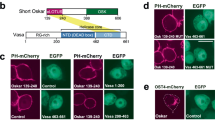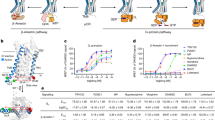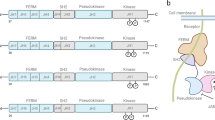Abstract
Feedback inhibition is a fundamental principle in signal transduction allowing rapid adaptation to different stimuli. In mammalian cells, the major feedback inhibitor for G-protein-coupled receptors (GPCR) is G-protein-coupled receptor kinase 2 (GRK-2), which phosphorylates activated receptors, uncouples them from G proteins and initiates their internalization1,2. The functions of GRK-2 are indispensable and need to be tightly controlled3. Dysregulation promotes disorders such as hypertension4 or heart failure5. In our search for a control mechanism for this vital kinase, here we show that the Raf kinase inhibitor protein6,7,8 (RKIP) is a physiological inhibitor of GRK-2. After stimulation of GPCR, RKIP dissociates from its known target, Raf-1 (refs 6–8), to associate with GRK-2 and block its activity. This switch is triggered by protein kinase C (PKC)-dependent phosphorylation of the RKIP on serine 153. The data delineate a new principle in signal transduction: by activating PKC, the incoming receptor signal is enhanced both by removing an inhibitor from Raf-1 and by blocking receptor internalization. A physiological role for this mechanism is shown in cardiomyocytes in which the downregulation of RKIP restrains β-adrenergic signalling and contractile activity.
This is a preview of subscription content, access via your institution
Access options
Subscribe to this journal
Receive 51 print issues and online access
$199.00 per year
only $3.90 per issue
Buy this article
- Purchase on Springer Link
- Instant access to full article PDF
Prices may be subject to local taxes which are calculated during checkout




Similar content being viewed by others
References
Krupnick, J. G. & Benovic, J. L. The role of receptor kinases and arrestins in G protein-coupled receptor regulation. Annu. Rev. Pharmacol. Toxicol. 38, 289–319 (1998)
Lefkowitz, R. J., Pitcher, J., Krueger, K. & Daaka, Y. Mechanisms of β-adrenergic receptor desensitization and resensitization. Adv. Pharmacol. 42, 416–420 (1998)
Jaber, M. et al. Essential role of β-adrenergic receptor kinase 1 in cardiac development and function. Proc. Natl Acad. Sci. USA 93, 12974–12979 (1996)
Gros, R., Benovic, J. L., Tan, C. M. & Feldman, R. D. G-protein-coupled receptor kinase activity is increased in hypertension. J. Clin. Invest. 99, 2087–2093 (1997)
Ungerer, M., Böhm, M., Elce, J. S., Erdmann, E. & Lohse, M. J. Altered expression of β-adrenergic receptor kinase and β2-adrenergic receptors in the failing human heart. Circulation 87, 454–463 (1993)
Yeung, K. et al. Suppression of Raf-1 kinase activity and MAP kinase signalling by RKIP. Nature 401, 173–177 (1999)
Yeung, K. et al. Mechanism of suppression of the Raf/MEK/extracellular signal-regulated kinase pathway by the raf kinase inhibitor protein. Mol. Cell. Biol. 20, 3079–3085 (2000)
Corbit, K. C. et al. Activation of Raf-1 signaling by protein kinase C through a mechanism involving Raf kinase inhibitory protein. J. Biol. Chem. 278, 13061–13068 (2003)
Slupsky, J. R. et al. Binding of Gβγ subunits to cRaf1 downregulates G-protein-coupled receptor signalling. Curr. Biol. 9, 971–974 (1999)
Diviani, D. et al. Effect of different G protein-coupled receptor kinases on phosphorylation and desensitization of the α1B-adrenergic receptor. J. Biol. Chem. 271, 5059–5058 (1996)
Dicker, F., Quitterer, U., Winstel, R., Honold, K. & Lohse, M. J. Phosphorylation-independent inhibition of parathyroid hormone receptor signaling by G protein-coupled receptor kinases. Proc. Natl Acad. Sci. USA 96, 5476–5481 (1999)
Lohse, M. J., Benovic, J. L., Caron, M. G. & Lefkowitz, R. J. Multiple pathways of rapid β2-adrenergic receptor desensitization. Delineation with specific inhibitors. J. Biol. Chem. 265, 3202–3211 (1990)
Pitcher, J. A. et al. Role of βγ subunits of G proteins in targeting the β-adrenergic receptor kinase to membrane-bound receptors. Science 257, 1264–1267 (1992)
Krasel, C. et al. Phosphorylation of GRK2 by protein kinase C abolishes its inhibition by calmodulin. J. Biol. Chem. 276, 1911–1915 (2001)
Eichmann, T. et al. The amino-terminal domain of G-protein-coupled receptor kinase 2 is a regulatory Gβγ binding site. J. Biol. Chem. 278, 8052–8057 (2003)
Yu, Q. M. et al. The amino terminus with a conserved glutamic acid of G protein-coupled receptor kinases is indispensable for their ability to phosphorylate photoactivated rhodopsin. J. Neurochem. 73, 1222–1227 (1999)
Maudsley, S. et al. The β2-adrenergic receptor mediates extracellular signal-regulated kinase activation via assembly of a multi-receptor complex with the epidermal growth factor receptor. J. Biol. Chem. 275, 9572–9580 (2000)
Hasuwa, H., Kaseda, K., Einarsdottir, T. & Okabe, M. Small interfering RNA and gene silencing in transgenic mice and rats. FEBS Lett. 532, 227–230 (2002)
Kallal, L., Gagnon, A. W., Penn, R. B. & Benovic, J. L. Visualization of agonist-induced sequestration and down-regulation of a green fluorescent protein-tagged β2-adrenergic receptor. J. Biol. Chem. 273, 322–328 (1998)
Mason, C. S. et al. Serine and tyrosine phosphorylations cooperate in Raf-1, but not B-Raf activation. EMBO J. 18, 2137–2148 (1999)
AbdAlla, S., Lother, H. & Quitterer, U. AT1-receptor heterodimers show enhanced G-protein activation and altered receptor sequestration. Nature 407, 94–98 (2000)
AbdAlla, S., Lother, H., el Massiery, A. & Quitterer, U. Increased AT1 receptor heterodimers in preeclampsia mediate enhanced angiotensin II responsiveness. Nature Med. 7, 1003–1009 (2001)
Darman, R. B. & Forbush, B. A regulatory locus of phosphorylation in the N terminus of the Na-K-Cl cotransporter, NKCCl. J. Biol. Chem. 277, 37542–37550 (2002)
AbdAlla, S., Lother, H., Abdel-tawab, A. M. & Quitterer, U. The angiotensin II AT2 receptor is an AT1 receptor antagonist. J. Biol. Chem. 276, 39721–39726 (2001)
Ritter, O. et al. AT2 receptor activation regulates myocardial eNOS expression via the calcineurin-NFAT pathway. FASEB J. 17, 283–285 (2003)
Wu, J. C., Tsai, R. Y. & Chung, T. H. Role of catenins in the development of gap junctions in rat cardiomyocytes. J. Cell. Biochem. 88, 823–835 (2003)
Dunigan, C. D., Curran, P. K. & Fishman, P. H. Detection of β-adrenergic receptors by radioligand binding. Methods Mol. Biol. 126, 329–343 (2000)
Acknowledgements
We thank W. Kolch for RKIP cDNA plasmids, M. Hoffmann for technical assistance, C. Dees for purification of GRK-2, M. Philipp for help with mouse tissue preparation, H. Mischak for PKCα and PKCδ, N. Burkard and S. Oberdorf-Maass for assistance in preparing cardiomyocytes, and S. Freund for determination of cardiomyocyte beating frequency. This work was supported by the Deutsche Forschungsgemeinschaft.
Author information
Authors and Affiliations
Corresponding author
Ethics declarations
Competing interests
The authors declare that they have no competing financial interests.
Rights and permissions
About this article
Cite this article
Lorenz, K., Lohse, M. & Quitterer, U. Protein kinase C switches the Raf kinase inhibitor from Raf-1 to GRK-2. Nature 426, 574–579 (2003). https://doi.org/10.1038/nature02158
Received:
Accepted:
Issue Date:
DOI: https://doi.org/10.1038/nature02158
This article is cited by
-
BTB protein family and human breast cancer: signaling pathways and clinical progress
Journal of Cancer Research and Clinical Oncology (2023)
-
Genome-wide characterization of PEBP family genes in nine Rosaceae tree species and their expression analysis in P. mume
BMC Ecology and Evolution (2021)
-
Cytoplasmic eIF6 promotes OSCC malignant behavior through AKT pathway
Cell Communication and Signaling (2021)
-
The inhibitor effect of RKIP on inflammasome activation and inflammasome-dependent diseases
Cellular & Molecular Immunology (2021)
-
GRK2 enforces androgen receptor dependence in the prostate and prostate tumors
Oncogene (2020)
Comments
By submitting a comment you agree to abide by our Terms and Community Guidelines. If you find something abusive or that does not comply with our terms or guidelines please flag it as inappropriate.



